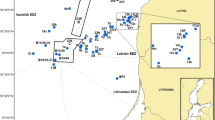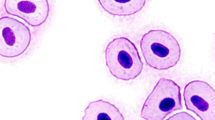Abstract
Eight nuclear abnormalities of genotoxicity and cytotoxicity were studied in peripheral blood erythrocytes of herring (Clupea harengus membras), flounder (Platichthys flesus), and Atlantic cod (Gadus morhua) sampled (2010–2017) from the Polish and the Lithuanian Exclusive Economic Zones (EEZ) in the Baltic Sea. At all study stations, total genotoxicity (∑Gentox) was found to be higher than total cytotoxicity (∑Cytox). A significant time-related decrease in genotoxicity was detected in the Lithuanian EEZ (2015–2017), while in the Polish EEZ (2014–2016), the opposite tendency was revealed. The highest ∑Gentox and ∑Cytox values recorded in fish sampled at the study stations located relatively close to each other clearly indicate an increased environmental genotoxicity and cytotoxicity pressure for fish in these areas. Exceptionally high and high-level genotoxicity risks to herring followed by those to flounder and cod were determined at a higher percentage of the stations studied.










Similar content being viewed by others
References
Baršienė J, Rybakovas A, Garnaga G, Andreikėnaitė L (2012a) Environmental genotoxicity and cytotoxicity studies in mussels before and after an oil spill at the marine oil terminal in the Baltic Sea. Environ Monit Assess 184:2067–2078
Baršienė J, Lyons B, Rybakovas A, Martinez-Gomez C, Andreikėnaitė L, Brooks S, Maes T (2012b) Background document: micronucleus assay as a tool for assessing cytogenetic/DNA damage in marine organisms, pp 71–83. In: Davies IM, Vethaak D (eds) Integrated marine environmental monitoring of chemicals and their effects. ICES Cooperative Research Report, 315. ICES, Copenhagen, 277 pp
Baršienė J, Rybakovas A, Lang T, Grygiel W, Andreikėnaitė L, Michailovas A (2012c) Risk of environmental genotoxicity in the Baltic Sea over the period of 2009–2011 assessed by micronuclei frequencies in blood erythrocytes of flounder (Platichthys flesus), herring (Clupea harengus) and eelpout (Zoarces viviparus). Mar Environ Res 77:35–42
Baršienė J, Butrimavičienė L, Grygiel W, Lang T, Michailovas A, Jackūnas T (2014) Environmental genotoxicity and cytotoxicity in flounder (Platichthys flesus), herring (Clupea harengus) and Atlantic cod (Gadus morhua) from chemical munitions dumping zones in the southern Baltic Sea. Mar Environ Res 96:56–67
Baršienė J, Butrimavičienė L, Grygiel W, Stunžėnas V, Valskienė R, Greiciūnaitė J, Stankevičiūtė M (2016) Environmental genotoxicity assessment along the transport routes of chemical munitions leading to the dumping areas in the Baltic Sea. Mar Pollut Bull 103:45–53
Bełdowski J, Fabisiak J, Popiel S, Őstin A, Olsson U, Vanninen P, Latsumaki A, Lang T, Fricke N, Brenner M, Berglind R, Baršienė J et al (2014) CHEMSEA findings. Institute of Oceanology, Polish Academy of Sciences, Gdansk, p 86
Bełdowski J, Klusek Z, Szubska M, Turja R, Bulczak AI, Rak D, Brenner M, Lang T, Kotwicki L, Grzelak K, Jakacki J, Fricke N, Östin A, Olsson U, Fabisiak J, Garnaga G, Nyholm JR, Majewski P, Broeg K, Söderström M, Vanninen P, Popiel S, Nawała J, Lehtonen K, Berglind R, Schmidt B (2016) Chemical Munitions Search & Assessment – an evaluation of the dumped munitions problem in the Baltic Sea. Deep-Sea Res Part II: Top Stud Oceanogr 128:85–95
Brooks SJ, Harman C, Grung M, Farmen E, Ruus A, Vingen S, Godal BF, Baršienė J, Andreikėnaitė L, Skarphéðinsdóttir H, Liewenborg B, Sundt RC (2011) Water column monitoring of the biological effects of produced water from the Ekofisk offshore oil installation from 2006 to 2009. J Toxicol Environ Health A 74:582–604
Bulczak AI, Rak D, Schmidt B, Bełdowski J (2016) Observations of near-bottom currents in Bornholm Basin, Slupsk Furrow and Gdansk Deep. Deep-Sea Res Part II: Top Stud Oceanogr 128:96–113
Counihan KL (2018) The physiological effects of oil, dispersant and dispersed oil on the bay mussel, Mytilus trossulus, in Arctic/Subarctic conditions. Aquat Toxicol 199:220–231
Della Torre C, Petochi T, Corsi I, Dinardo MM, Baroni D, Alcaro L, Focardi S, Tursi A, Marino G, Frigeri A, Amato E (2010) DNA damage, severe organ lesions and high muscle levels of As and Hg in two benthic fish species from a chemical warfare agent dumping site in the Mediterranean Sea. Sci Total Environ 408:2136–2145
Della Torre C, Petochi T, Farchi C, Corsi I, Dinardo Sammarini V, Alcaro L, Mechelli L, Focardi S, Tursi A, Marino G, Amato E (2013) Environmental hazard of yperite released at sea: sublethal toxic effects on fish. J Hazard Mater 248-249:246–253
Fenech M, Chang WP, Kirsch-Volders M, Holland N, Bonassi S, Zeiger E (2003) HUMN project: detailed description of the scoring criteria for the cytokinesis-block micronucleus assay using isolated human lymphocyte cultures. Mutat Res 534:65–75
GIOŚ (2013) Wstępna ocena stanu środowiska wód morskich polskiej strefy morza bałtyckiego, Raport do Komisji Europejskiej, GIOŚ, Sopot (in Polish)
Hannam ML, Bamber SD, Sundt RC, Galloway TS (2009) Immune modulation in the blue mussel Mytilus edulis exposed to North Sea produced water. Environ Pollut 157:1939–1944
Harman C, Brooks S, Sundt RC, Meier S, Grung M (2011) Field comparison of passive sampling and biological approaches for measuring exposure to PAH and alkylphenols from offshore produced water discharges. Mar Pollut Bull 63:141–148
HELCOM (2010) Hazardous substances in the Baltic Sea – An integrated thematic assessment of hazardous substances in the Baltic Sea. Balt. Sea Environ. Proc. No. 120B
HELCOM (2013) Climate change in the Baltic Sea Area: HELCOM thematic assessment in 2013. Balt. Sea Environ. Proc. No. 137
Hylland K, Tollefsen KE, Ruus A, Jonsson G, Sundt RC, Sanni S, Utvik TIR, Johnsen S, Nilssen I, Pinturier L, Balk L, Baršienė J, Marigo’mez I, Feist SW, Børseth JF (2008) Water column monitoring near oil installations in the North Sea 2001–2004. Mar Pollut Bull 56:414–429
Hylland K, Robinson CD, Burgeot T, Martínez-Gomez C, Lang T, Svavarsson J, Thain JE, Vethaak AD, Gubbins MJ (2017) Integrated chemical and biological assessment of contaminant impacts in selected European coastal and offshore marine areas. Mar Environ Res 124:130–138
IARC (2010) Some non-heterocyclic polycyclic aromatic hydrocarbons and some related exposures. IARC Monogr Eval Carcinog Risks Hum 92:1–853
ICES (2011) Report of the study group on integrated monitoring of contaminants and biological effects (SGIMC), 14e18 March 2011, Copenhagen, Denmark. ICES CM 2011/ACOM: 30., 265 pp.
LOTOS (2014) Integrated annual report: http://2014.raportroczny.lotos.pl/en/results-and-prospects/segment-performance/exploration-and-production. Accessed 23 Oct 2018
Möller G (2011) How to maximize the efficiency and focus the national and multi-national mine clearance activities to the areas most needed. In: Third International Dialogue on Underwater Munitions. Sopot, Poland, pp 16. Available at: http://www.underwatermunitions.org/pdf/IDUM_3rd_Press_final.pdf Accessed 23 Oct 2018
Pampanin D, Larssen E, Øysæd KB, Sundt RC, Sydnes MO (2014) Study of the bile proteome of Atlantic cod (Gadus morhua): multi-biological markers of exposure to polycyclic aromatic hydrocarbons. Mar Environ Res 101:161–168
Sanderson H, Fauser P, Thomsen M, Sørensen PB (2008) Screening level fish community risk assessment of chemical warfare agents in the Baltic Sea. J Hazard Mater 154:846–857
Sanderson H, Fauser P, Thomsen M, Vanninen P, Savin Y, Hirvonen A, Missiaen T, Polyak Y, Paka V, Niiranen S, Borodin P, Medvedeva N, Feller P, Soderstrom M, Khalikov I, Zhurbas V, Gress A (2010) Feature: risk assessment of chemical munitions dumped in the Baltic Sea in 1947. Environ Sci Technol 44:4389–4394
Sanni S, Björkblom C, Jonsson H, Godal BF, Liewenborg B, Lyng E, Pampanin DM (2017a) I: Biomarker quantification in fish exposed to crude oil as input to species sensitivity distributions and threshold values for environmental monitoring. Mar Environ Res 125:10–24
Sanni S, Lyng E, Pampanin DM, Smit MGD (2017b) II. Species sensitivity distributions based on biomarkers and whole organism responses for integrated impact and risk assessment criteria. Mar Environ Res 127:11–23
Sanni S, Lyng E, Pampanin DM (2017c) III: Use of biomarkers as Risk Indicators in Environmental Risk Assessment of oil based discharges offshore. Mar Environ Res 127:1–10
Sundt RC, Pampanin DM, Grung M, Baršienė J, Russ A (2011) PAH body burden and biomarker responses in mussels (Mytilus edulis) exposed to produced water from a North Sea oil field: laboratory and field assessments. Mar Pollut Bull 62:1498–1505
Sundt RC, Russ A, Jonsson H, Skarphéðinsdóttir H, Meier S, Grung M, Beyer J, Pampanin D (2012) Biomarker responses in Atlantic cod (Gadus morhua) exposed to produced water from a North Sea oil field: laboratory and field assessments. Mar Pollut Bull 64:144–152
Valskienė R, Baršienė J, Butrimavičienė L, Grygiel W, Stunžėnas V, Jokšas K, Stankevičiūtė M (2018) Environmental genotoxicity and cytotoxicity levels in herring (Clupea harengus), flounder (Platichthys flesus) and cod (Gadus morhua) inhabiting the Gdansk Basin of the Baltic Sea. Mar Pollut Bull 133:65–76
Vethaak AD, Davies IM, Thain JE, Gubbins MJ, Martínez-Gömez C, Robinson CD, Moffat CF, Burgeot T, Maes T, Wosniok W, Giltrap M, Lang T, Hylland K (2017) Integrated indicator framework and methodology for monitoring and assessment of hazardous substances and their effects in the marine environment. Mar Environ Res 124:10–20
Zalewska T, Woron J, Danowska B, Suplinska M (2015) Temporal changes in Hg, Pb, Cd and Zn environmental concentrations in the southern Baltic Sea sediments dated with 210Pb method. Oceanologia. 57:32–43
Acknowledgements
The authors would like to thank Dr. Thomas Lang ((Thűnen Institute of Fisheries Ecology, Cuxhaven, Germany) for collecting samples from station B09 (December 2011, December 2012, September 2013) during the RV Walther Herwig III cruises.
Author information
Authors and Affiliations
Corresponding author
Ethics declarations
Conflict of interests
The authors declare that they have no conflict of interest.
Additional information
Responsible editor: Philippe Garrigues
Publisher’s note
Springer Nature remains neutral with regard to jurisdictional claims in published maps and institutional affiliations.
Highlights
• Environmental factor-induced nuclear abnormalities were studied in herring, flounder, and cod erythrocytes.
• Fish were sampled from 52 study stations located in the Polish and Lithuanian EEZs in 2010–2017.
• The assessment of environmental genotoxicity and cytotoxicity to fish revealed time- and zone-related differences.
• Exceptionally high and high level genotoxicity risks to herring were found at 96%, to flounder at 92% and to cod at 39% of the study stations in the Polish EEZ.
• Exceptionally high and high level genotoxicity risks to herring were found at 100%, to flounder at 86% and to cod at 33% of the study stations in the Lithuanian EEZ.
Rights and permissions
About this article
Cite this article
Valskienė, R., Baršienė, J., Butrimavičienė, L. et al. Induction of nuclear abnormalities in herring (Clupea harengus membras), flounder (Platichthys flesus), and Atlantic cod (Gadus morhua) collected from the southern part of the Gotland Basin—the Baltic Sea (2010–2017). Environ Sci Pollut Res 26, 13366–13380 (2019). https://doi.org/10.1007/s11356-019-04687-0
Received:
Accepted:
Published:
Issue Date:
DOI: https://doi.org/10.1007/s11356-019-04687-0




